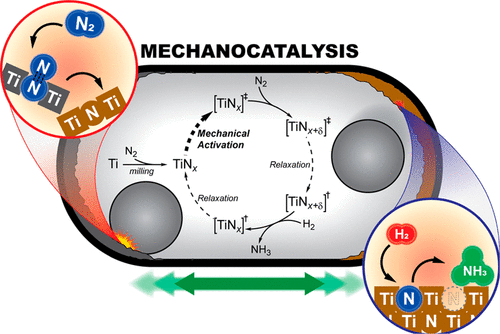
To meet global food demands, environmentally friendly and energy efficient ways to produce ammonia for fertilizer production are essential.
Currently ammonia is obtained almost exclusively through the Haber-Bosch process, which operates at high temperatures and requires specialized facilities and centralized plants. This has inhibited ammonia production in developing regions, restricting access to fertilizers and limiting agricultural output.
However, a team led by researchers in Georgia Tech’s School of Chemical and Biomolecular Engineering (ChBE) has demonstrated a new approach to mechanocatalytically synthesize ammonia under nominally ambient conditions that could enable localized, on-demand production in developing parts of the world.
The researchers, who recently published their study in ACS Energy Letters, applied mechanical energy to drive the reaction in ball mills.
Milling titanium powder in a vibratory ball mill with a stainless steel milling vessel modified to allow a steady gas flow of nitrogen and hydrogen resulted in the formation of titanium nitride (TiN) and the continuous synthesis of ammonia without the need for external heating or pressuring.
“You don’t have to heat a reactor because the balls create localized hot spots,” explains ChBE Professor Carsten Sievers. “Because of the localized energy input, reactions that traditionally require elevated temperatures and pressures can occur in reactors at nominally ambient conditions.”
He adds: “The beauty of this is that because we don’t need pressure vessels and advanced heat integration, we could build this system into a unit that would fit anywhere from a tabletop to a truck mill. Everything we’ve done so far is in small quantities, but this approach should be much more scalable than Haber-Bosch.”
Currently, there are many large-scale ammonia production facilities, but these are often great distances from farmers in developing nations, which can face steep logistical bills to transport fertilizer. “Our new localized, on-demand approach could reduce transportation times, mechanical inventories, and the risk of accidents during shipping,” Sievers says.
In addition to Sievers, Georgia Tech-affiliated authors of the study (titled “Mechanocatalytic Ammonia Synthesis over TiN in Transient Microenvironments”) include ChBE graduate students Andrew Tricker and Karoline Hebisch, ChBE Professor Andrew J. Medford, Mechanical Engineering Professor Marta C. Hatzell, and Civil and Environmental engineering graduate student Yu-Hsuan Liu. They collaborated with Marco Buchmann and Marcus Rose of the Technical University of Darmstadt and Eli Stavitski of Brookhaven National Laboratory.
The researchers note that the idea of using mechanical forces has potential beyond ammonia production for many other kinds of processes, including the depolymerization of plastic and biomass conversion.
Researchers pictured below: Andrew Tricker, Karoline Hebisch, and Carsten Sievers
Brad Dixon, braddixon@gatech.edu